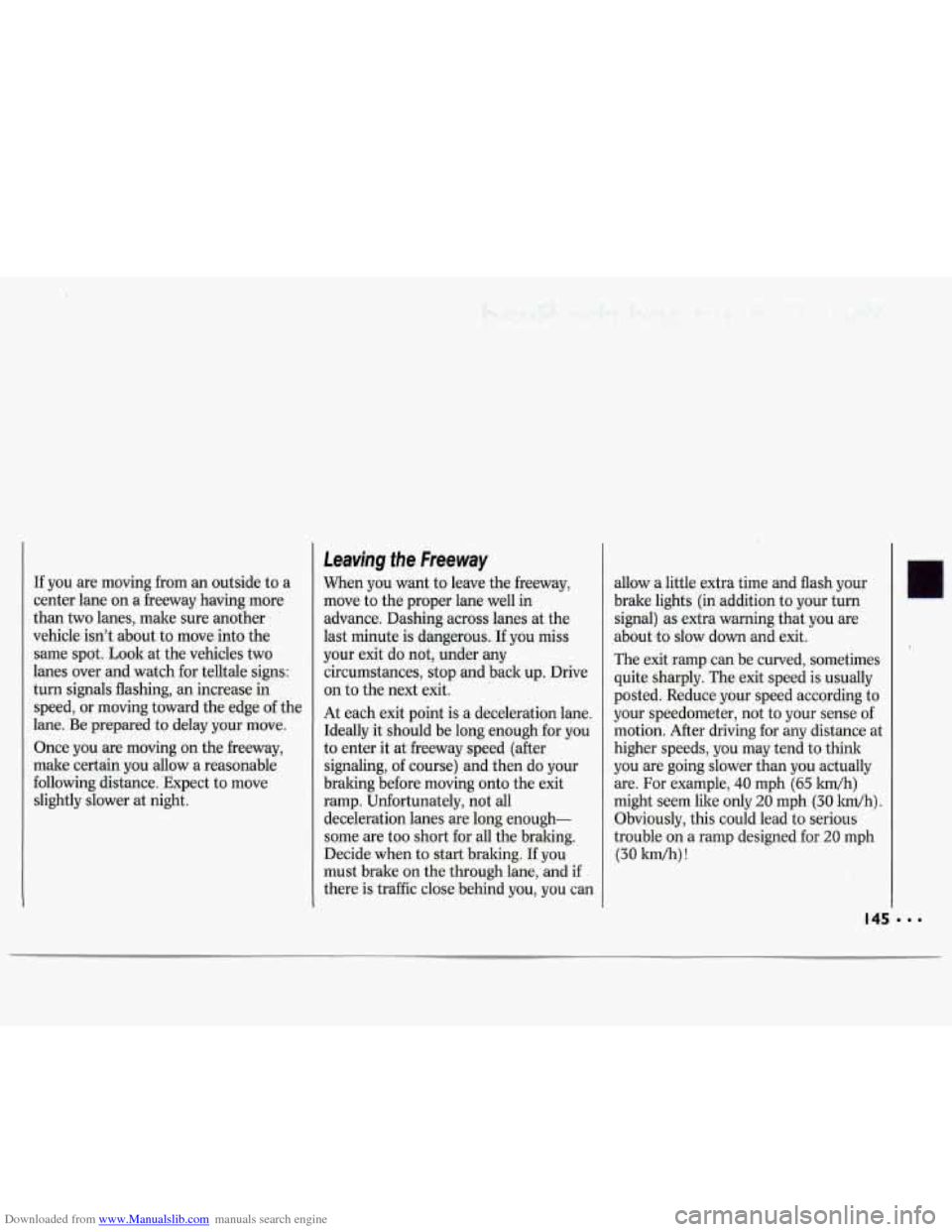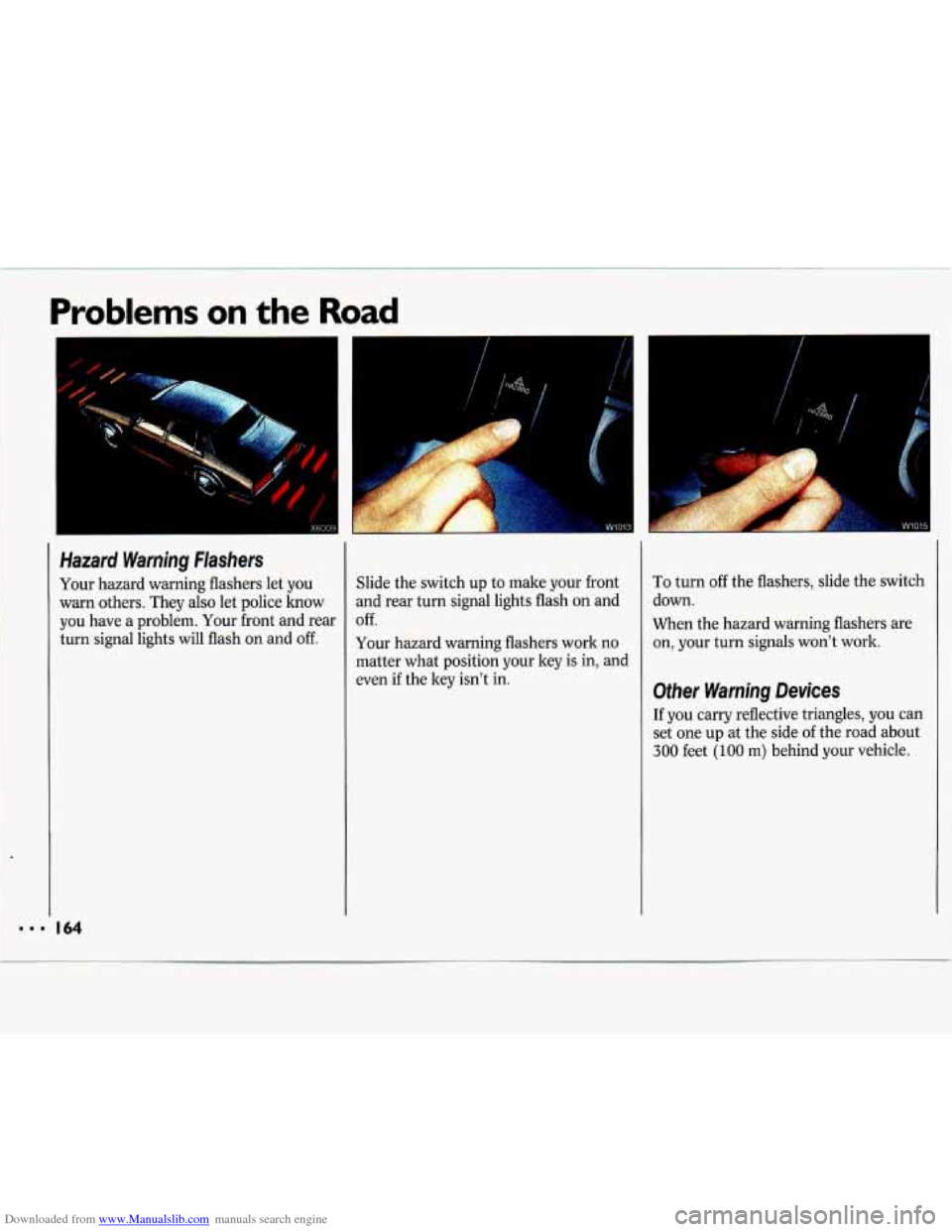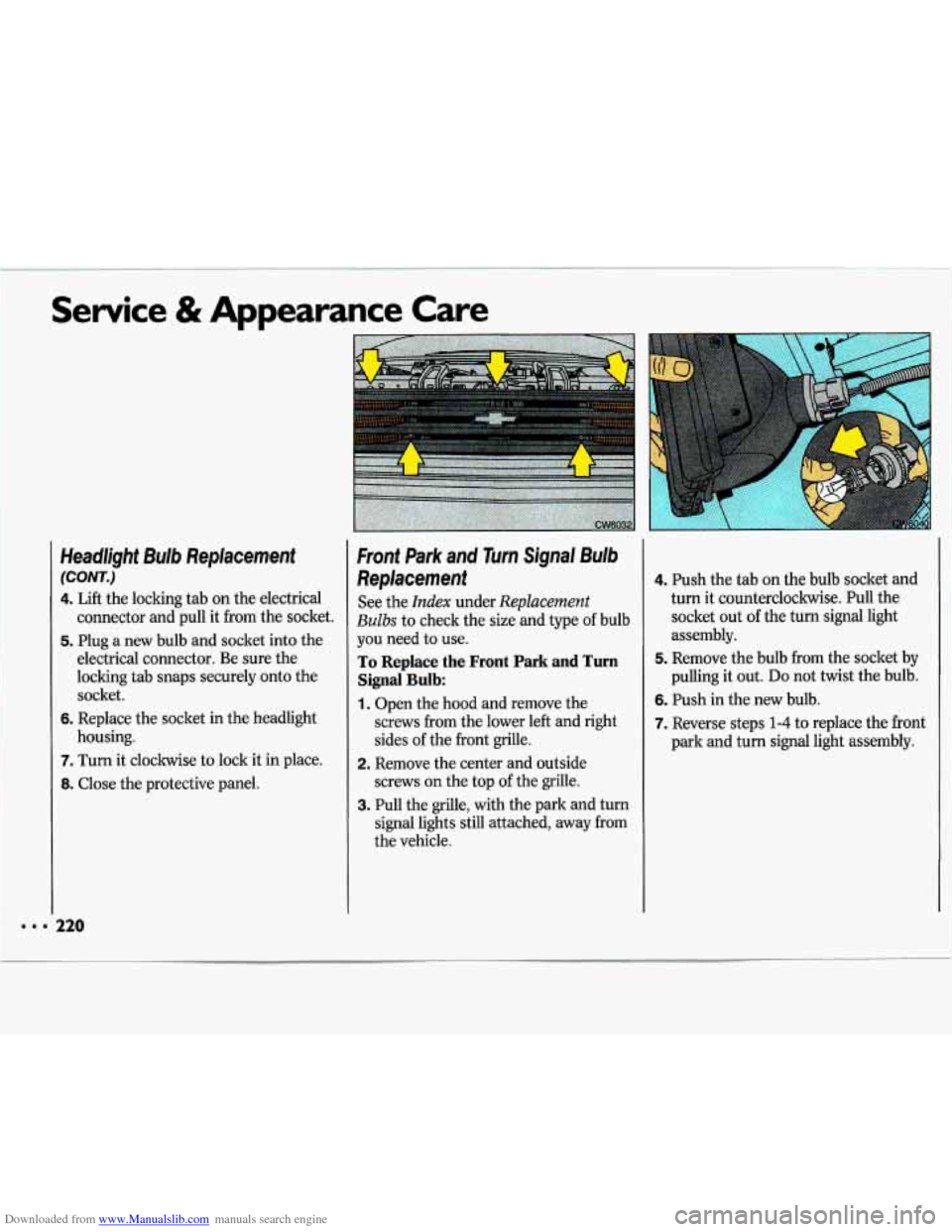1993 CHEVROLET LUMINA turn signal
[x] Cancel search: turn signalPage 145 of 324

Downloaded from www.Manualslib.com manuals search engine course you want to respect another’s
property, but you might need to put
something between you and moving
vehicles-space, trees, telephone poles,
a private driveway, anything that
removes you from other traffic.
If visibility
is near zero and you must
stop but are unsure whether you are
away from the road, turn your hghts on,
start your hazard warning flashers, and
sound your horn at intervals or when
you hear approaching traffic.
Pass other vehicles in fog only if you
can see far enough ahead to pass safely.
Even then, be prepared to delay your
pass if you suspect the fog
is worse up
ahead.
If other vehicles try to pass you,
make it easy for them.
Cify Driving
One of the biggest problems with city
streets is the amount of traffic on them.
You’ll want to watch
out for what the
other drivers are doing and pay
attention to traf€ic signals.
Here are ways to increase your safety in
city driving:
Know the best way to get to where
you are going.
Try not to drive around
trying to pick out a familiar street or
landmark. Get
a city map and plan
your trip into an unlmown part of the
city
just as you would for a cross-
country trip.
Try to use the freeways that rim and
crisscross most large cities. You’ll
save time and energy. (See the next
section,
Freway Driving.)
Treat a green light as a warning
signal.
A traffic light is there because
the corner is busy enough to need
it.
When a light turns green, and just
before you start to move, check both
ways for vehicles that have not
cleared the intersection or may be
running the red light.
Obey all posted speed limits. But
remember that they are for ideal road,
weather and visibility conditions.
You
may need to drive below the posted
limit in bad weather or when visibility
is especially poor.
Pull to the right (with care) and stop
clear of intersections when you see or
hear emergency vehicles.
Page 146 of 324

Downloaded from www.Manualslib.com manuals search engine Your Driving and the Road
Freeway Driving
Mile for mile, freeways (also called
thruways, parkways, expressways,
turnpikes, or superhighways) are the
safest
of all roads. But they have their
own special rules.
The most important advice on freeway
driving is: Keep up with traffic and keep
to the right. Drive at the same speed
most of the other drivers are driving.
Too-fast or too-slow driving breaks a
smooth traffic flow. Treat the left lane
on a freeway as a passing lane.
I44
Entering the Freeway
At the entrance there is usually a ramp
that leads to the freeway.
If you have a
clear view of the freeway as you drive
along the entrance ramp, you should
begin to check traffic. Try to determine
where you expect to blend with the
flow. If traffic is light, you may have no
problem. But if it is heavy, find a gap as
you move along the entering lane and
time your approach. Try to merge into
the gap at close to the prevailing speed.
Switch on your turn signal, check your
rearview mirrors
as you move along,
and glance over your shoulder as often
as necessary.
Try to blend smoothly
with the traffic flow.
Driving on the Freeway
Once you are on the freeway, adjust
your speed to the posted limit or to the
prevailing rate
if it’s slower. Stay in the
right lane unless you want to pass. If
you are on a two-lane freeway, treat the
right lane as the slow lane and the left
lane as the passing lane.
If you are on a three-lane freeway, treat
the right lane as the slower-speed
through lane, the middle lane as the
higher-speed through lane, and the left
lane as the passing lane.
Before changing lanes, check your
rearview mirrors. Then use your turn
signal.
Just before you leave the lane,
glance quickly over your shoulder to
make sure there isn’t another vehicle in
your “blind” spot.
Page 147 of 324

Downloaded from www.Manualslib.com manuals search engine If you are moving from an outside to a
center lane on a freeway having more
than two lanes, make sure another
vehicle isn’t about to move into the
same spot. Look at the vehicles two
lanes over and watch for telltale signs:
turn signals flashing, an increase in
speed, or moving toward the edge
of the
lane. Be prepared to delay your move.
Once you are moving on the freeway,
make certain you allow
a reasonable
following distance. Expect to move
slightly slower at night.
Leaving the Freeway
When you want to leave the freeway,
move to the proper lane well in
advance. Dashing across lanes at the
last minute is dangerous. If you miss
your exit do not, under any
circumstances, stop and back up. Drive
on to the next exit.
At each exit point is a deceleration lane.
Ideally it should be long enough for you
to enter it at freeway speed (after
signaling,
of course) and then do your
braking before moving onto the exit
ramp. Unfortunately, not all
deceleration lanes are long enough-
some are too short for all the braking.
Decide when to start braking. If you
must brake on the through lane, and if
there is traffic close behind you, you can allow a little extra time and flash your
brake lights (in addition to your turn
signal) as extra warning that you are
about
$0 slow down and exit.
The exit ramp can be curved, sometimes quite sharply. The exit speed is usually
posted. Reduce your speed according to
your speedometer, not to your sense of
motion. After driving for any distance at
higher speeds, you may tend to think
you are going slower than you actually
are. For example,
40 mph (65 lun/h)
might seem like only
20 mph (30 lmih).
Obviously, this could lead to serious
trouble on a ramp designed for
20 mph
(30 Wh)!
Page 149 of 324

Downloaded from www.Manualslib.com manuals search engine On the Road
Unless you are the only driver, it is good
to share the driving task with others.
Limit turns behind the wheel to about
100 miles (160 km) or two hours at a
sitting. Then, either change drivers or
stop for some refreshment like coffee,
tea or soft drinlts and some limbering
up. But do stop and move around. Eat
lightly along the way. Heavier meals
tend to make some people sleepy.
On two-lane highways or undivided
multilane highways that do not have
controlled access, you’ll want to watch
for some situations not usually found
on freeways. Examples are: stop signs
and signals, shopping centers with
direct access to the highway, no passing
zones and school zones, vehicles
turning left and right off the road,
pedestrians, cyclists, parked vehicles, and even animals.
Highway Hypnosis
Is there actually such a condition as
“highway hypnosis”? Or is it just plain
falling asleep at the wheel? Call it
highway hypnosis, lack of awareness, or
whatever.
There is something about an easy
stretch of road with the same scenery,
along with the hum of the tires on the
road, the drone of the engine, and the
rush of the wind against the vehicle that
can make you sleepy. Don’t let it
happen to you! If it does, your vehicle
can leave the road in
less than a second,
and you could crash and be injured.
What can you do about highway
hypnosis? First, be aware that it can
happen.
Then here are some tips:
Make sure your vehicle is well
ventilated, with a comfortably cool interior.
Keep your eyes moving. Scan the road
ahead and to the sides. Check your
rearview mirrors frequently and your
instruments from time to time. This
can help you avoid a fixed stare.
Wear good sunglasses in bright light.
Glare can cause drowsiness. But don’t
wear sunglasses at night. They will
drastically reduce your overall vision
at the very time you need all the
seeing power you have.
If you get sleepy, pull off the road into
a rest, service, or parking area and
take a nap, get some exercise, or both.
For safety, treat drowsiness on the
highway as an emergency.
As in any driving situation, keep pace
with traffic and allow adequate
following distances.
Page 162 of 324

Downloaded from www.Manualslib.com manuals search engine Your Driving and the Road
Driving with a Trailer (CONT.)
Making Turns
When you’re turning with a trailer, make wider turns than normal. Do this
so your trailer won’t strike soft
shoulders, curbs, road signs, trees, or
other objects. Avoid jerky or sudden
maneuvers. Signal well in advance.
Turn Signals When Towing a Trailer
When you tow a trailer, your vehicle has
to have a different turn signal flasher
and extra wiring. The green arrows on
your instrument panel will flash
whenever you signal a turn or lane
change. Properly hooked up, the trailer
lights will also flash, telling other
drivers you’re about to turn, change
lanes or stop.
I60
When towing a trailer, the green arrows
on your instrument panel will flash for
turns even if the bulbs on the trailer are
burned out. Thus, you may think
drivers behind you are seeing your
signal when they are not. It’s important
to check occasionally to be sure the
trailer bulbs are still working.
Your vehicle has bulb warning .lights.
When you plug trailer lights into your
vehicle’s lighting system, its bulb
warning lights may not let you know if
one
of your lights goes out. So, when
you have trailer lights plugged in, be
sure to check your vehicle and trailer
lights from time to time to be sure
they’re all working. Once you disconnect the trailer lights, the bulb
warning lights again can tell you if one
of your vehicle lights
is out.
Driving On Grades
Reduce speed and shift to a lower gear
before you start down a long or steep
downgrade. If you don’t shift down,
you
might have to use your brakes so much
that they would get hot and no longer
work well.
On a long uphill grade, shift down and
reduce your speed to around
45 mph
(70 Wh) to reduce the possibility of
engine and transaxle overheating.
If you are towing a trailer and you have
an automatic transaxle with Overdrive,
it’s best to drive in
D instead of (or,
as you need to, a lower gear). This will
minimize heat build-up and extend the
life of your transaxle.
Page 166 of 324

Downloaded from www.Manualslib.com manuals search engine Problems on the Road
.L
Hazard Warning Flashers
Your hazard warning flashers let you warn others. They also let police know you have a problem. Your front and rear
turn signal lights will flash on and off.
I I
Slide the switch up to make your front
and rear turn signal lights flash on and
off.
Your hazard warning flashers work no
matter what position your key
is in, and
even if the key isn't in.
... w101.5
To turn off the flashers, slide the switch
down.
When the hazard warning flashers are
on, your turn signals won't work.
Other Warning Devices
If you carry reflective triangles, you can
set one up at the side of the road about
300 feet (100 rn) behind your vehicle.
Page 222 of 324

Downloaded from www.Manualslib.com manuals search engine Service & Appearance Care
HwdDghf Bulb Replacement
(COW..)
4. Lift the lacking tab on the electrical
connector
and pd it from the socket.
5. plug a new bulb ayld socket into the
electxical cannectur, Be sure the
lacking tab
snaps securely onto the
socket.
6. Replace the socket in the headlight
housing.
7. Turn it clockwise to lo& it in place.
8. Close the protective panel,
4. Push the tab on the bulb socket and I
turn it c=own.t~do;ckwise. 9ull the
assembly.
5. Remove the bulb from the socket by
palling
it out. De not twist the bulb.
6. Push in the new bulb.
7. Reverse steps 1-4 to replace the front
park and turn signal light assembly.
socket out of the tw [email protected]
I
Page 224 of 324

Downloaded from www.Manualslib.com manuals search engine Service & Appearance Care
Center High-Mounted Stoplight
Bulb Replacement
(CONT.)
2. Lift the locking tabs at the top and
bottom and pull the bulb and socket
out of the center high-mounted
stoplight assembly.
3. Pull the bulb from the socket.
4. Push the new bulb into the socket.
5. Replace the bulb and socket in the
assembly. Make sure the locking tabs
snap in place.
6. Replace the cover and screws.
TailStop/Turn Signal Bulb
Replacement
See the Index under Replacement
Bulbs to check the type of bulb to use.
To Replace a Bulb:
1. Open the trunk. Remove the
convenience net
if you have one.
Remove the carpet fasteners by
twisting them a little as you pull them
away from the carpet.
the vehicle.
2. Pull the carpet away from the rear of
3. Unscrew the three wing nuts and pull
the light assembly
from the vehicle.